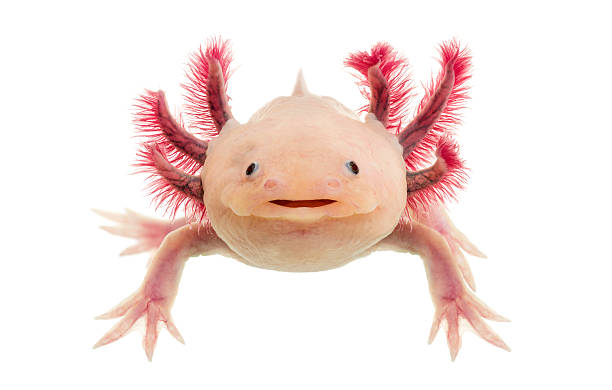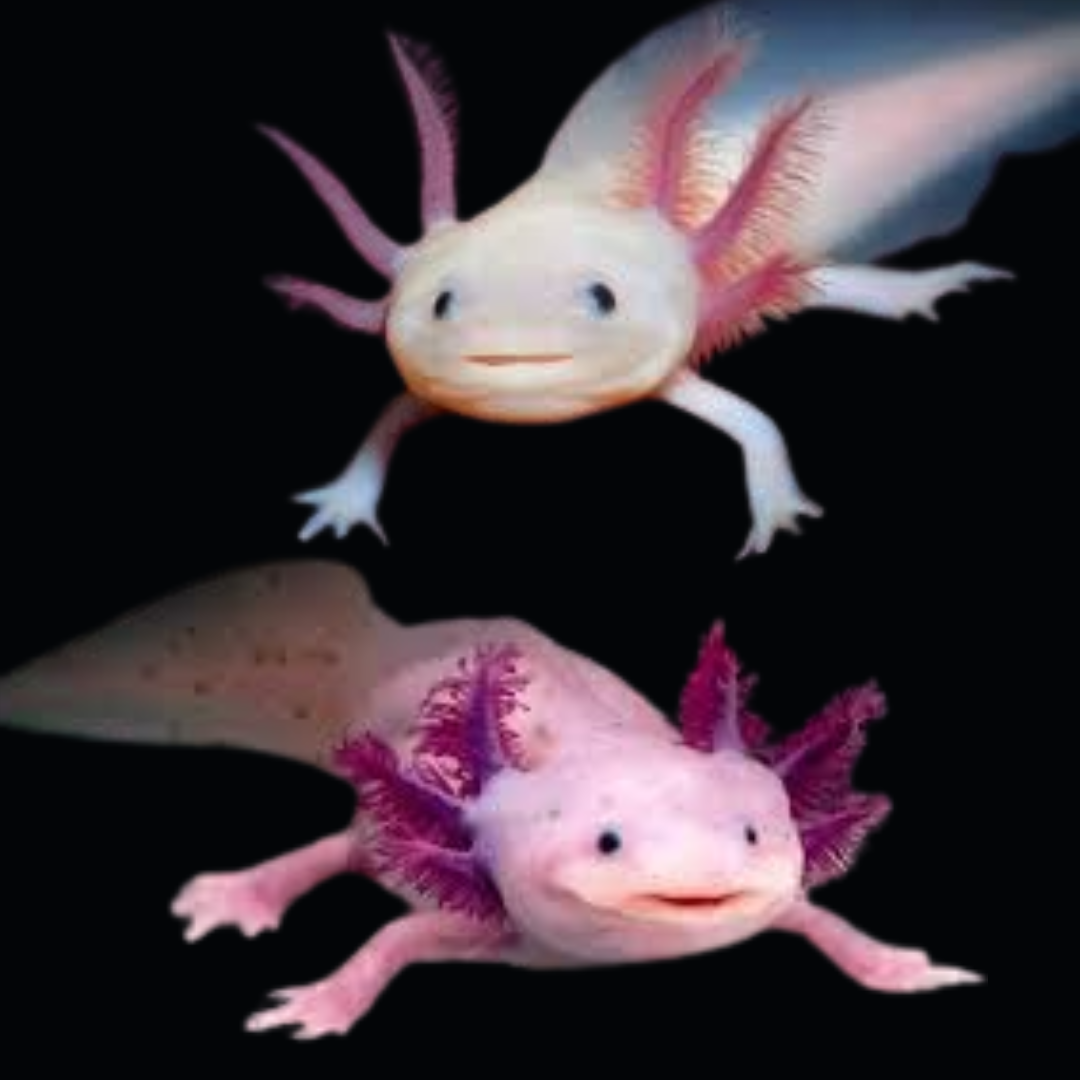The axolotl is one very unique animal. These salamanders have an unusual smile that makes them look friendly and cute. But their quirky grins are just the start –
- The axolotl is the Aztec god of fire and lightning
- Finding a mate involves dancing
- Never show signs of ageing
- Can Regrow even parts of their brain and spinal cord
- Found only in one tiny area of Mexico City
- These “walking fish” are so rare in the wild that they’re critically endangered.
Despite this, axolotls have exploded in popularity as exotic pets thanks to their bizarre looks and incredible biological abilities. From regenerating body parts to inspiring official city emojis, axolotls have captured our imagination and raised important questions about protecting nature’s most unbelievable creations.
Let’s Dive deeper
The axolotl is the Aztec god of fire and lightning
With its difficult-to-pronounce name (ACK-suh-LAH-tuhl), the axolotl’s origins are rooted in ancient Aztec folklore. The components “atl,” meaning water, and “xolotl,” referring to a strange dog-headed deity, come together in Nahuatl, the Aztec language.
Some tales recount how Xolotl, the god of fire and lightning, transformed himself into this curious amphibian to avoid being sacrificed by rivals. With its perpetual grin, the axolotl was seen as Xolotl’s new guise to slink unnoticed through the waterways surrounding Xochimilco.
Finding a mate involves dancing
When it comes time to mate, the axolotl has a charming courtship ritual that is sure to make even the most hardened soul crack a smile. As these aquatic salamanders reach sexual maturity around one year old, the males perform an entertaining “dance” to attract females.
Come breeding season in February, a male will undulate his tail and lower body regions in what resembles the mesmerizing movements of a hula dancer. He’ll sway his hindquarters with rippling motions in an attempt to woo nearby female axolotls.
If a female finds his shimmying body beguiling, she’ll swim over and nudge him responsive with her snout to accept his advances. It’s a peculiar andalizaringly tender mating ritual befitting such a charmingly weird “monster” of the natural world.
Axolotls can regenerate new body parts.
One of the axolotl’s most studied and remarkable traits is its regenerative abilities. These phenomenal creatures can effectively re-grow entire limbs, tails, portions of their lower jaw, and, remarkably, even parts of their brain and spinal cord with minimal scarring over just a few months. The regrowth occurs spontaneously, without any special treatment required beyond a functioning nervous system. Such powerful regenerative capacity makes axolotls a critical subject for medical research into tissue and organ regrowth in humans.
The feathery-looking headdress isn’t for show

One of the axolotl’s most distinctive features is the plume of wispy red filaments protruding from its head, which resembles ornamental headgear. While whimsical in appearance, this crown serves a vital purpose—it’s actually the axolotl’s gills. These feathery branches allow the axolotl to breathe indefinitely underwater without ever developing lungs like its fellow amphibian relatives. The intricate gill structure extracts oxygen from the water to sustain the axolotl in its permanent larval state.
They Never show signs of ageing

Axolotls possess the incredible ability of neoteny, meaning they can reproduce and reach adulthood without ever metamorphosing into their terrestrial “final form” like other salamanders. While closely related salamanders, like the tiger salamander, go through a tadpole stage before developing lungs and taking to land, axolotls bypass this transformation entirely. They spend their entire life cycle immersed in water, maturing into sexually reproductive adults while retaining their iconic feathery gills and larval characteristics.
Wild axolotls are rarely white or pink.

While many of us are familiar with the endearing white or pink axolotl varieties, these lighter shades are actually the result of selective breeding programs. In their native Mexican lakes and canals, axolotls typically appear in much darker hues. Rich brown or inky black colors mottled with olive green and gold patterns allow these “water monsters” to blend seamlessly into their murky aquatic environment in the wild. The striking leucistic and albino forms beloved by pet owners today descended from a single mutant male specimen shipped to Paris in the 1860s for scientific study.
They’re critically endangered (Disturbing facts about mexican axolotl)
Sadly, this amazing example of evolution’s creativity is perilously close to disappearing forever in the wild. Decades of urban development leading to habitat destruction, water pollution, and the introduction of invasive predatory species like tilapia and carp have driven axolotl numbers to critical lows. A 1998 survey estimated around 6,000 individuals remained, but just 10 years later, only about 100 survivors could be located. So dire was the situation that, for a period in 2014, biologists feared the axolotl had finally gone extinct in its natural Mexico City home before a handful were thankfully rediscovered.
They can only be found in one place in the world.
Remarkably, these unique creatures now exist in just one location on planet Earth: the lake system of Xochimilco, a borough in southern Mexico City. Until the 1980s, axolotls could also be spotted in a second lake nearby, but the draining of that body of water due to urban flooding eliminated that remaining wild habitat. Their continued survival now hinges entirely on preservation efforts in the Xochimilco wetlands area
You can eat mexican axolotl
Among other useful facts about Mexican axolotl is that it is eatable. In the past, before its threatened status, the axolotl was viewed as a food source by indigenous Mexicans. The amphibians were commonly incorporated into regional dishes like tamales, with accounts describing their flavor as similar to eating a small, crunchy-skinned fish when fried whole. This delicacy is still prepared in some areas today, particularly in Japan, where chefs deep-fry the axolotls before serving. As an endangered species nowadays, however, many conservationists caution against consuming these rare salamanders to avoid further population decline.
Sometimes axolotls can grow up (with a little push)
Although transformation goes against their biology, axolotls can be induced to undergo metamorphosis under controlled conditions. By administering precise doses of iodine to replicate thyroid hormones, scientists can override the axolotl’s neoteny and trigger the rapid development of the lungs and other adult salamander traits. Within just a few months, axolotls take on a lizard-like appearance more akin to that of regular terrestrial salamanders, though they remain unable to reproduce with those species. This process is incredibly stressful and disruptive, however, causing many to dissuade owners from attempting home experiments.
Axolotls inspired Mexico City’s official emoji set
As an instantly recognizable symbol from the Xochimilco wetlands, the axolotl was a natural pick when Mexico City launched a contest in 2017 to design a set of 20 official emoji stickers representing the region. The winning submission by local artist Itzel Oropeza Castillo featured the amphibian’s grinning face among the metro, cactus, and mariachi graphics chosen to promote the city’s identity online and in messaging apps. The pop culture longevity of this “water monster” is quite remarkable for such an endangered species.
They’re hugely popular in the pet trade
While the axolotl’s future hangs by a thread in the wild, an explosion in demand as an exotic pet has put over 1 million specimens into aquariums and tanks worldwide. Their unique appearance, mysterious smiles, and reputation as a low-maintenance companion have proven catnip for exotic pet enthusiasts, despite many jurisdictions banning private ownership. Whether the popularity of the pet trade will help or hinder future conservation of this wholly aquatic creature with such distinct evolutionary traits remains to be seen.
Wrapping up
From their humble origins in Mexican folklore to international acclaim as an internet sensation, these grinning amphibians have brought wonder and amazement wherever they swim. The axolotl’s incredible neoteny and regenerative powers are a reminder that nature’s marvels often lurk in unexpected places. By protecting this “water monster” and learning from its ancient biological secrets, we ensure future generations can experience the sheer delight of the axolotl’s signature smile.